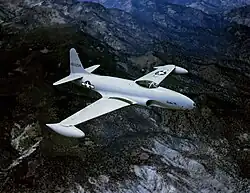Windstar YF-80
| YF-80 | |
|---|---|
| Role | Homebuilt aircraft |
| National origin | United States |
| Manufacturer | Windstar |
The Windstar YF-80 is an American single-seat homebuilt replica of the Lockheed F-80.[1] By 1987, the project was not complete, resulting in a court case between investors. The prototype was re-engined with a Turbomeca Marboré II turbine engine, as the Stargate YT-33.[2]
Design and development

The YF-80 is a two-thirds scale replica of a Lockheed F-80 or T-33. The aircraft is a composite-construction, single-engine, low-wing design, with retractable tricycle landing gear. The tip tanks are removable for aerobatic flight.[3] The aircraft is powered by a Chevy 350 V-8 turbocharged engine driving a turbine thrust section. The thrust section is driven by belts with high gear ratios to drive the turbine closer to the rotational speed it was originally designed for.[4]
The aircraft project was intended to showcase the Davis engine technology, with a static prototype displayed in 1977. Burt Rutan was approached to build the composite fuselage, but the US$240,000 cost estimate was declined. Davis attempted to produce a production prototype fuselage for US$80,000.
Stargate YT-33
| YT-33 | |
|---|---|
| Role | Homebuilt aircraft |
| National origin | United States |
| Manufacturer | Stargate, Inc. |
| Retired | 2018 |
| Status | Production completed (1994) |
| Number built | One |
| Developed from | Lockheed T-33 Windstar YF-80 |
The Stargate YT-33 is an American turbine powered prototype[5] homebuilt aircraft that was designed and intended to be produced by Stargate, Inc., of McMinnville, Oregon. It was introduced in 1994. The aircraft is a 2/3 scale replica of the Lockheed T-33 jet trainer.[6] Listed as "under development" in 1998, the YT-33 was planned to be supplied as a kit for amateur construction, but it is unlikely any kits were ever shipped.[6]
Design and development
The YT-33 features a cantilever low wing, a two-seats-in-tandem enclosed cockpit under a bubble canopy, retractable tricycle landing gear, and a single jet engine.[6]
The aircraft is made from composite material. Its 26.67 ft (8.1 m) span wing has a wing area of 110.0 sq ft (10.22 m2). The prototype uses a 880 lbf (3.9 kN) thrust Turbomeca Marboré IIC jet powerplant.[6][7]
The aircraft has a typical empty weight of 2,205 lb (1,000 kg) and a gross weight of 2,920 lb (1,320 kg), giving a useful load of 715 lb (324 kg). The aircraft has a fuel capacity of 200 U.S. gallons (760 L; 170 imp gal) or 1,358 lb (616 kg) of Jet-A.[6]
The ISA standard temperature, sea-level, no-wind, take-off distance is 2,000 ft (610 m), and the landing roll is 3,000 ft (914 m).[6]
The manufacturer estimated the construction time from the proposed kit to be 3000 hours.[6]
Operational history
By 1998, the company reported that one YT-33 had been completed and was flying.[6] On April 18, 2018 the one example that had been registered in the United States with the Federal Aviation Administration was de-registered; the aircraft may not exist any longer.[7]
Specifications
YF-80
Data from Jane's all the world's aircraft, 1978-79[8]
General characteristics
- Crew: 1
- Length: 17 ft 3 in (5.26 m)
- Wingspan: 18 ft 6 in (5.64 m)
- Height: 6 ft 1 in (1.85 m)
- Empty weight: 899 lb (408 kg)
- Max takeoff weight: 1,301 lb (590 kg) with internal fuel only
- Fuel capacity: 132.5 liters (35 US gallons)
- Powerplant: 1 × Davis Cold Jet hybrid piston turbine, 220 lbf (0.98 kN) thrust @ 75% power
Performance
- Maximum speed: 261 kn (300 mph, 483 km/h)
- Stall speed: 70 kn (80 mph, 129 km/h) with flaps down
- Range: 425 nmi (490 mi, 788 km) with internal fuel only
- Service ceiling: 20,000 ft (6,100 m)
- g limits: +6/-3
- Rate of climb: 2,600 ft/min (13 m/s) with internal fuel only
YT-33
Data from AeroCrafter[6]
General characteristics
- Crew: one
- Capacity: one passenger
- Length: 25 ft 10 in (7.87 m)
- Wingspan: 26 ft 8 in (8.13 m)
- Wing area: 110.0 sq ft (10.22 m2)
- Aspect ratio: 6.6:1
- Empty weight: 2,205 lb (1,000 kg)
- Gross weight: 2,920 lb (1,324 kg)
- Fuel capacity: 200 U.S. gallons (760 L; 170 imp gal)
- Powerplant: 1 × Turbomeca Marboré IIC jet aircraft engine, 880 lbf (3.9 kN) thrust
Performance
- Maximum speed: 325 mph (523 km/h, 282 kn)
- Cruise speed: 300 mph (480 km/h, 260 kn)
- Stall speed: 75 mph (121 km/h, 65 kn)
- Range: 1,200 mi (1,900 km, 1,000 nmi)
- Service ceiling: 30,000 ft (9,100 m)
- Rate of climb: 1,500 ft/min (7.6 m/s)
References
- ^ Garrison, Peter (November 1977). "Homebuilder Heaven". Flying Magazine. New York: Ziff-Davis. pp. 72–74, 133. Retrieved June 12, 2023.
- ^ de Piolenc, F. Marc; Wright, George E. Jr. Ducted Fan Design. Vol. 1 (Revised ed.). p. 92.
- ^ Gallagher, Sheldon M. & Levy, Howard (January 1978). "New homebuilts: Classy looks with a dash of the old days". Popular Mechanics. New York: Hearst Corporation. pp. 54–56, 116. Retrieved June 12, 2023.
- ^ Flight International. August 22, 1977.
{{cite journal}}: Missing or empty|title=(help) - ^ "Stargate MT33". Retrieved December 1, 2013.
- ^ a b c d e f g h i Purdy, Don (July 15, 1998). AeroCrafter: Homebuilt Aircraft Sourcebook (5th ed.). BAI Communications. p. 359. ISBN 0-9636409-4-1.
- ^ a b "N-Number Inquiry Results - N91SH". Federal Aviation Administration. July 22, 2022. Retrieved July 22, 2022.
- ^ Taylor, John W. R. (1978). Jane's All the World's Aircraft 1978–79. London: Jane's Yearbooks. p. 552. ISBN 0-35-400572-3.